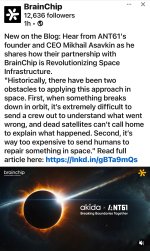Contextual Computing Requires an AI-First Approach
OPINION
By Vikram Gupta 04.08.2024
The infusion of AI into internet of things (IoT) edge devices has the potential to realize the vision of intelligent, contextually aware computing that intuitively acts on our behalf based on seemingly a
priori knowledge. As we move through this world, our engagement with technology is frictionless, fluid, productive and trusted. Without prompt, home automation systems know users’ habits and needs; factories know when maintenance is needed; emergency services deliver medical care promptly; agricultural lands have optimal yields; and ecologies are sustained—a pathway to a better world.
This is what’s possible when IoT islands are knit together intelligently, securely, reliably and cost effectively. We’re not there yet, but with an edge computing market set to grow rapidly in the next two years, the industry is accelerating in that direction.
AI-infused IoT
The promise of the IoT as a transformative force remains intact, but it has been slowed by several challenges: fragmented hardware and software ecosystems, user privacy concerns, a cloud-centric data processing model with slow response times, and unreliable connectivity. The infusion of AI at the edge addresses two of these issues by allowing decisions to be made quickly in situ, with no need to upload user data. This tackles the latency and privacy issues while making better use of available bandwidth and lowering power consumption by reducing the number of transmissions.
Given this, solutions that skillfully handle edge IoT data while ensuring the seamless integration of AI for enhanced contextual awareness and improved IoT features will surely gain popularity. This is why so many companies have been seeking to incorporate the value of AI as they deploy smarter IoT products across consumer, industrial and automotive markets.
Interest in doing so has only spiked with the rapid emergence of large language models (LLMs). While AI and ML have been evolving quickly within the context of the IoT, an exciting overlap between LLMs and edge AI is the emergence of small language models (SLMs) that will aid in the hyper-personalization of the end user and drive more compute to the edge.
Meanwhile, practical applications of AI-infused edge IoT are already gaining traction in areas like feature enhancement for home video devices. Edge AI can also optimize crowd flow, ensure security, and enhance user experiences in retail, public transportation, and entertainment venues through people counting and behavioral analysis.
AI paralysis
While the opportunities are compelling, companies’ ability to capitalize on them varies. Some product companies have data but don’t have AI models or even know where to begin developing them. Others are more sophisticated and have models but can’t deploy them effectively across unproven hardware and ever-shifting, incompatible tool suites. Others remain paralyzed in the face of a technological revolution that will up-end their business if they don’t act quickly.
While it makes devices more useful, edge AI adds complexity and further frustrates developers, customers and users. They all recognize the potential of intelligent, connected nodes to enhance the user experience but lack the know-how, tools, and infrastructure to capitalize upon this relatively new and exciting technology. The spike in edge AI interest has resulted in sporadic ad hoc solutions hitched to legacy hardware and software tools with development environments that don’t efficiently capitalize upon AI’s potential to address customer demand for AI enablement for applications they’ve yet to clarify.
This situation is untenable for developers and end users, and the issue comes into stark relief against a backdrop of AI compute being increasingly pushed from the data center to the edge in applications like healthcare and finance, where security and response time are paramount. Clearly, more needs to be done by the industry to improve the customer journey to enable intelligent edge products.
Close the AI gap: Concept to deployment
While the edge AI train has already left the station, will different nodes have different shades of intelligence? Logic would dictate that everything would be intelligent, yet the degree of intelligence depends on the application. Some intelligence might be externally visible as a product feature, but others may not.
Regardless, if everything is going to be intelligent, it would follow that AI shouldn’t be a bolt-on “feature,” but inherent in every IoT product. Getting customers from ideation to real-world deployment requires shifting from the currently fragmented ecosystem to a cohesive, AI-first approach to IoT edge device design. This will require several elements: scalable AI-native hardware, unified software, more adaptive frameworks, a partnership-based ecosystem and fully optimized connectivity. This is the only way developers can deploy AI at the edge at the requisite speed, power, performance, reliability, security and cost point required to take part in a future that is coming…fast.
Many necessary elements are already available thanks to work done over the years on applying AI to vision, audio, voice and time series data. However, processor scalability and multi-modal capability need more attention to enable cost-effective, contextually aware sensing across increasingly diverse applications. While current microcontrollers and microprocessors are each highly capable in their own right, a gap still exists for the right IoT processors with the right mix of power, performance and processing flexibility to ensure the right compute at each edge AI node.
These suitable IoT processors, combined with compatible wireless connectivity and supported by a cohesive infrastructure, software, development tools and a truly “AI first” approach to ease the customer journey, will unlock a number of intelligent IoT products to help improve our world
.
—Vikram Gupta is SVP and GM of IoT processors and Chief Product Officer at Synaptics.




